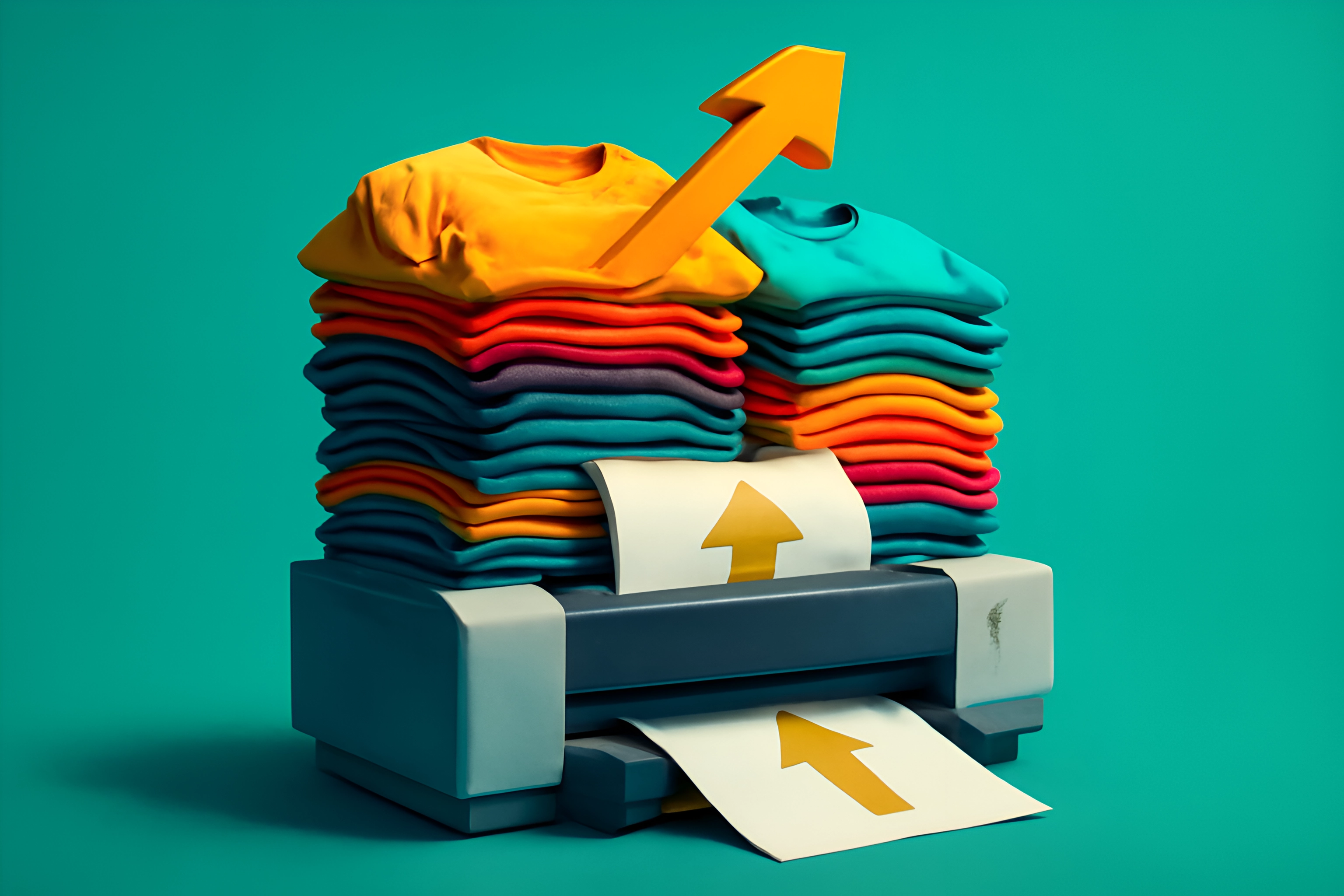
So, you've launched your print-on-demand store. You've made some sales, you know your way around Printful or Printify, but now you've hit a wall. The hustle feels more "active" than "passive," and the dream of a hands-off income stream feels just out of reach.
You're not alone. Many sellers get stuck here, battling inconsistent sales, razor-thin margins, and the crushing feeling of being lost in a saturated market. You see other stores taking off, and you wonder, what's their secret?
This isn't another beginner's guide. This is for those who have mastered the basics and are ready to transition from a POD hobby to a scalable, automated income machine. We're about to pull back the curtain on the advanced print-on-demand growth hacks passive income earners use to separate themselves from the pack. By implementing strategic niche refinement, multi-platform expansion, and smart automation, you can transform your POD business into a powerful engine for true financial freedom.
The Foundational Shift: Moving from Creator to CEO
The single most powerful growth hack isn't a tool or a tactic—it's a seismic shift in your mindset. To truly scale, you must stop thinking like a designer who occasionally sells things and start operating like a CEO who builds a brand. This is the line between a side hustle that drains your time and an asset that builds your wealth.
Embrace Data, Not Just Design
It's time to move beyond, "I think this looks cool." Your personal taste doesn't pay the bills; market demand does. The top earners use data to drive every decision, validating ideas before they ever open a design app. Dive into your platform analytics, whether it's Etsy Stats or Shopify Analytics, to identify your actual bestsellers and understand who your customers really are.
Use tools like Google Trends or niche-specific platforms like eRank to spot rising demand and uncover hidden opportunities. According to a detailed analysis of POD profitability, success hinges on data-driven decisions and targeted marketing to stand out. This is how you stop guessing and start building a profitable online venture with minimal investment, creating products you know people want to buy.
Build a Brand, Not Just a Store
Why can one store sell a graphic tee for $35 while another struggles to sell a similar one for $20? The answer is brand. A cohesive brand identity—your logo, color palette, and tone of voice—builds the trust and emotional connection that justifies a premium price.
Your brand should be instantly recognizable across every mockup, product description, and social media post. It tells a story that resonates with your ideal customer, making them feel like part of a tribe. This is what turns one-time buyers into loyal fans who eagerly await your next drop and proudly recommend you to their friends.
Advanced Niche Strategy: How to Dominate, Not Just Compete
In a market projected to hit nearly $38 billion by 2030, the key to unlocking serious growth isn't trying to appeal to everyone. The real print on demand scaling strategies involve going deeper, not wider. You must become the undisputed king or queen of a very specific castle.
Niche Down, Then Cross-Niche
Forget broad categories like "gifts for nurses." That's a red ocean, filled with sharks. The advanced strategy is to cross-niche, combining two or more distinct interests into a hyper-specific audience that nobody else is serving properly. Think gifts for ER nurses who love coffee and sarcasm.
This is where the magic happens. You're no longer competing with thousands of generic stores; you're the only one speaking directly to a passionate, underserved group. Other powerful cross-niches could be Vintage Sci-Fi + Knitting or Book Lovers + Weightlifting. This precision targeting makes your marketing effortless because your products feel like they were made just for them.
The Trend-Tapping vs. Evergreen Framework
A truly resilient POD empire is built on two pillars: the stable foundation and the lightning strike. You need a strategic mix of evergreen designs and trend-tapped products. Your evergreen core consists of designs that sell year-round—targeting timeless hobbies, professions, and life events. This is your reliable, month-over-month income.
Then, you have trend-tapping for quick cash injections. Monitor TikTok, Twitter, and news cycles for memes or cultural moments you can quickly turn into a design. Speed is everything here. While these designs have a short shelf life, they can generate massive, immediate revenue. A smart approach is the 80/20 rule: dedicate 80% of your effort to building your evergreen foundation and 20% to capitalizing on fleeting trends.
Strategic Expansion: Platforms & Products for Higher Margins
Are you putting all your eggs in one basket? Relying solely on Etsy or a single product type is a rookie mistake that caps your earning potential and leaves you vulnerable. True scaling requires strategic diversification across both platforms and products to create a stable, high-margin business.
The Multi-Channel Sales Engine (Etsy + Shopify + Amazon)
The smartest sellers use platforms in tandem, leveraging each one for its unique strengths. This multi-channel approach creates a powerful sales engine that captures customers at every stage of their buying journey. It's one of the most effective growth hacks for print on demand.
- Etsy: Use it for discovery. Etsy's massive, built-in marketplace is perfect for testing new designs and attracting initial customers with minimal ad spend.
- Shopify: Use it for brand building and profit. Once you identify a winning design on Etsy, move it to your own Shopify store where you control the customer experience, own the email list, and keep a much higher percentage of the profit.
- Amazon Merch on Demand: Use it for sheer volume. Tapping into the world's largest e-commerce site gives your designs unparalleled reach, creating yet another passive income stream.
By understanding that Etsy is a key platform for POD sellers, you can create a funnel that moves customers from discovery to a branded, high-margin experience you own.
Go Beyond the T-Shirt: High-Perceived Value Products
The standard graphic tee has a profit margin that often hovers between 20% and 40%. To maximize passive income print on demand, you need to expand into products with a higher perceived value. Customers are willing to pay significantly more for items that feel more substantial or unique.
Think all-over-print hoodies, embroidered hats, custom blankets, metal wall art, and engraved phone cases. These products not only command higher prices but also set your brand apart from the sea of basic t-shirt sellers. Offering a curated catalog of premium items positions you as a high-quality brand, not just another POD store.
Marketing Automation: The "Passive" in Passive Income
Let's be honest: if you're manually posting to social media every day, your income isn't passive. True passive income comes from building automated systems that market and sell for you 24/7, even while you sleep. This is where you turn your effort into an asset that works for you.
The Automated Pinterest Machine
Stop thinking of Pinterest as social media. It's a visual search engine, and it's a goldmine for POD sellers. The strategy is simple but incredibly effective: create 5-10 unique pin templates in Canva for your products. Then, use a scheduler to automatically pin your mockups to dozens of relevant boards over weeks and months.
As a platform ideal for POD marketing, Pinterest allows you to set up a system that continuously drives free, targeted traffic to your products long after you've scheduled the pins. This is a true "set it and forget it" marketing machine that generates sales on autopilot.
Build Your Email List (Your #1 Asset)
Your email list is the only marketing channel you truly own. You aren't subject to algorithm changes or platform bans. Start building this asset from day one by offering a simple 10% discount on your Shopify store in exchange for an email address.
Once you have their email, set up an automated welcome sequence that introduces your brand story, showcases your bestsellers, and builds a relationship. Now, whenever you launch a new design, you can drive sales on demand by sending a single email. This is how you create predictable, repeatable revenue.
Leverage User-Generated Content (UGC)
What's more powerful than you saying your products are great? A happy customer showing off their purchase. User-generated content is the ultimate social proof, and you can automate the process of collecting it.
Include a small note in your product's package description or set up a follow-up email asking customers to share a photo on social media. Offer a small discount on a future purchase for tagging your brand. This not only provides you with a stream of free, authentic marketing content but also builds a community around your brand.
Conclusion: Your Blueprint for Scaling
You've seen the path. The days of hitting a plateau are over. Scaling your print-on-demand business isn't about working harder or creating hundreds of mediocre designs. It's about building smarter systems that elevate you from a simple creator to a strategic CEO.
By adopting a data-driven mindset, dominating a hyper-specific cross-niche, expanding across multiple platforms with high-value products, and automating your marketing, you create a resilient, scalable business. These are the building blocks for the hands-off, truly passive income stream you set out to build. You can find more foundational knowledge on unlocking passive income with print-on-demand strategies to complement these advanced tactics.
What is the first advanced strategy you're going to implement in your POD business? Share your plan in the comments below!
Frequently Asked Questions
Q1: How many designs do I need to make a significant passive income with POD?
A: It's less about quantity and more about quality and niche relevance. Twenty to thirty well-researched, high-quality designs in a proven cross-niche can dramatically outperform 500 generic ones. Focus on validating your ideas with data before you design.
Q2: Is it better to scale on Etsy or my own Shopify store?
A: Use both strategically. Start on Etsy to take advantage of its built-in traffic for discovery and design testing. As you identify winners and grow your audience, launch a Shopify store to build your brand, own your customer data, and achieve significantly higher profit margins.
Q3: How do I protect my best-selling designs from being copied?
A: While it's difficult to prevent copycats entirely in the digital world, you can take defensive measures. Regularly file DMCA takedown notices on platforms where you find infringements, subtly watermark your mockup images, and most importantly, focus on building a strong brand. A memorable brand, excellent customer service, and a loyal community are far harder to copy than a single design file.














